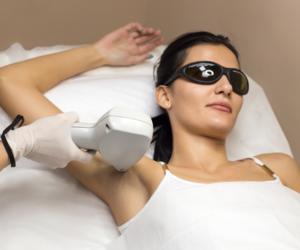Is Laser Hair Removal Painful?

What is laser hair removal?
Are you sick of using a razor or shaving creams every time you need to go to the beach and wear a bikini or when you are wearing a skirt and want to show off your legs? How about laser hair removal treatment? Laser hair removal is a treatment option based on photo thermolysis, which tends to slow down and destroy the hair follicles that are currently in the growing process.
It is good to know that almost any part of the human body can be treated with laser hair removal. The eyebrows are an exception to this, as they are too close to the eyes, and there is the possibility of severe eye damage if the laser is used in this area.
Almost anyone can benefit from a laser hair removal treatment. However, people with a light skin color and dark hair can benefit the most. People with gray hair, blond hair, as well as red hair will not benefit very much from this treatment, as the laser does not identify these hair colors well. Having a dark skin color will also prevent adequate results from laser hair removal for the same reason.
Don’t expect to have smooth and hairless skin with just one treatment. Usually, four to six treatments are required before your skin is smooth and hairless. This is due to the fact that hair is not growing all at the same time, and laser hair removal treatment only works with those hair follicles which are in the growing phase while the treatment is performed. A single treatment of laser hair removal lasts approximately a couple of minutes up to half an hour, depending on the area of the body that is being treated with laser.
Laser hair removal has certain advantages compared to using a razor, depilatory creams, or even waxing. However, it is normal for you to wonder if laser hair removal is accompanied by pain and if there are any risks, side effects, or complications following a laser hair removal treatment.
Is laser hair removal painful?
You can expect to feel some level of pain during the laser hair removal procedure. However, it’s not an intense burning or searing pain, and clients have described it as a flick of an elastic band, which is still not as painful as waxing as far as hair removal procedures go. Besides this slight pain during the procedure, the treated area might also become irritated and sensitive to pain. Redness and swelling is normal after the treatment.
The bottom line is that the pain and risks are minimal compared to the results you may be able to achieve with laser hair removal.
How to reduce the pain experienced
You could choose to bear through the pain if you desire, but there are ways to help reduce the pain you are going to experience:
Space out the sessions
To achieve long-term results, whereby hair does not grow back for at least a few years, you need to have several sessions. The recommended minimum is 7 sessions in order to kill the hair follicles in all three phases of growth. After the first session, you should wait at least 3 weeks before the next session to give adequate time for your skin to recover. Some clinics may want to squeeze in the sessions, or maybe you may be in a hurry, but this is not advisable. Regular bombardment of radiation to your skin may cause adverse effects, such as scarring and discoloration, and this would make the subsequent sessions much more painful than necessary. Therefore, you really need to pace yourself, despite your wishes for smooth, hairless skin.
Pain relievers
Despite the pain being only minimal, it doesn’t hurt to take measures to make it even more bearable. Taking an over-the-counter pain reliever like ibuprofen before and after the session will help you experience less pain before and after the procedure. Besides pain, ibuprofen will also help to relieve the inflammation caused by the procedure. There are also numbing creams available which can be used after the procedure to reduce the pain felt. Be careful, though, not to use too much because they have been shown to produce negative side effects. You may wish to ask your dermatologist about your options after treatment.
Turning down the radiation settings
You can still ask the person performing the procedure to tone down the level of radiation if you find the pain to be unbearable. Laser hair removal works by producing radiation that is absorbed by hair follicles and turned into heat, which then destroys the follicles. Since there are nerve endings under the skin, plenty of heat can cause these nerves to be activated, but reducing the amount of radiation subsequently lowers the level of heat around the skin, which lowers the pain felt by the nerves.
Avoid sensitive regions
Everyone is different, and we all have different pain thresholds - some might be able to withstand higher pain levels than others. Despite being safe, there is obviously more pain felt when laser hair removal is performed around sensitive areas like the bikini line or around reproductive organs. If you have a low pain tolerance, you should avoid using laser hair removal around these regions and find alternatives like hair removal creams.
Are there any side effects or complications following laser hair removal?
Like any other procedure, laser hair removal has its own risks and possible complications. However, if performed by a professional, these risks and complications are minimal. Make sure to choose a dermatologist or a plastic surgeon for the procedure. Avoid beauty salons as, in general, they don’t have a professional and certified staff member to use and work with the laser.
The most common side effect of a laser hair removal treatment is a certain level of skin redness and irritation. Usually, the skin redness and irritation resolves within a few hours, but sometimes it may require a day or two. If not used as recommended, laser hair removal treatments can result in skin burns, skin color changes like hyperpigmentation or hypopigmentation, as well as a formation of blisters, crusts, or skin scars.
As mentioned, laser hair removal treatment is safe and accompanied by only a little pain when performed by professionals. However, it can be dangerous, too, and it may be riddled with possible complications if not used properly.















